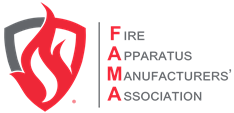Throughout the fire service industry, most fire departments, are aware that National Fire Protection Association (NFPA) 1901, Standard for Automotive Fire Apparatus (2016 ed.) and NFPA 1906, Standard for Wildland Fire Apparatus, (2016 ed.) became effective for all apparatus contracted on or after January 1, 2016. Members of the Fire Apparatus Manufacturers’ Association (FAMA) work hard to help develop these standards. While these standards are very important, they only apply to new apparatus. NFPA 1911, Standard for the Inspection, Maintenance, Testing, and Retirement of In-Service Automotive Fire Apparatus, is as important in that it provides guidance on how to ensure existing apparatus can continue operating in a safe and effective manner.
Background
Several weeks ago, a member of a local fire department approached me about a concern with fire apparatus maintenance within the department in which he served. Through the discussion, it became apparent that the individual was aware of NFPA 1911 but was having difficulty getting other members of the department to understand the value of the document or to use certain recommended practices within the document. I offered to go to the department and his city council meeting to discuss the benefits of using NFPA 1911 as a baseline for a maintenance program. What surprised me was the response. The individual spoke with members of the department, including the chief, about the offer of assistance. Members of the department, including the chief, indicated the department potentially had a negative view of the standard and felt as though the offer of assistance would lead to some form of regulation or management.
As I thought about the conversation and responses more, I felt compelled to write about the importance of having a maintenance program. It is concerning that there may be departments that do not have a maintenance program or do not understand the importance of NFPA 1911. It is true that neither the NFPA nor the federal government mandate adherence to NFPA 1911, but protecting the apparatus, those who ride in it, and those who use the equipment that is installed on it is of the utmost importance.
Operational Use of Fire Apparatus in Brief
Most fire apparatus are expensive and, by design, carry a large amount of weight. While they may not be driven for long periods of time and may be designed and built to standards that apply to new apparatus, the loads they carry and the extreme dynamics to which they are exposed can take a toll on systems such as brakes. Other systems, such as the fire pumping system or aerial device, may not be operated frequently, but this does not mean they are not subject to the extreme conditions to which fire apparatus are exposed. In more rural fire departments where the call volume may be low, and the apparatus is not driven or operated frequently, items such as tires, pump seals, or other elastomeric components may suffer from simply not being used.
Values of Maintenance, Inspection, and In-Service Testing
A maintenance, inspection, and in-service testing program is essential to protecting the lives of the people who use the apparatus as well as prolonging the life of the apparatus. This goes beyond oil changes, checking air pressure in the tires, and making sure the water tank is not leaking. A check list identifying inspection or maintenance criteria for critical systems of the apparatus should be implemented. Just because the call volume is low and the apparatus does not get exposed to a large number of hours of service does not mean the need for this check list is negated.
Frequent maintenance and inspections do come with a cost. However, identifying and correcting deficiencies in the apparatus systems early can prevent a future apparatus breakdown or a critical safety system failure. Identifying problems in the early stage can allow for planned repairs rather than breakdowns during an emergency response at a dramatically higher cost. Additionally, being able to plan maintenance or repairs reduces the amount of time the apparatus may be out of service.
In a department where pumping systems, compressed air foam systems, or aerial devices are not operated frequently, a regular inspection and maintenance program can mitigate problems during an emergency situation. Developing testing requirements and performing them on a regular basis ensures the systems operate and continue to operate as they were originally designed.
No Need to Reinvent the Wheel
Fire departments that do not have a regular maintenance and inspection program can develop their own. However, there is no need to “reinvent the wheel.” Throughout the 23 chapters, and various annexes in NFPA 1911, the work has been done to establish recommended best practices for maintenance and inspection for departments. It can be used as a baseline to establish inspection criteria while giving the fire department the liberty to choose the frequency that best suits its situation.
While most fire departments, as well as manufacturers of fire apparatus and associated equipment, have adopted NFPA 1901 and NFPA 1906, these standards only apply to new apparatus or equipment. A maintenance and inspection program is needed to ensure the apparatus and equipment continue to operate for years beyond their date of manufacture. While departments can create their own program, using NFPA 1911 can establish the baseline for a program that is conservative and comprehensive. FAMA encourages departments to consider adopting the maintenance guidelines found in NFPA 1911 so that new apparatus can be as reliable in the years to come as when first delivered.
FAMA is committed to the manufacture and sale of safe, efficient emergency response vehicles and equipment. FAMA urges fire departments to evaluate the full range of safety features offered by its member companies.
WESLEY D. CHESTNUT is the Product Safety and Compliance Manager for Spartan Motors, Inc. He provides regulatory oversight for all of Spartan. He works closely with federal agencies and other associations to promote the safety of various types of motor vehicles.
